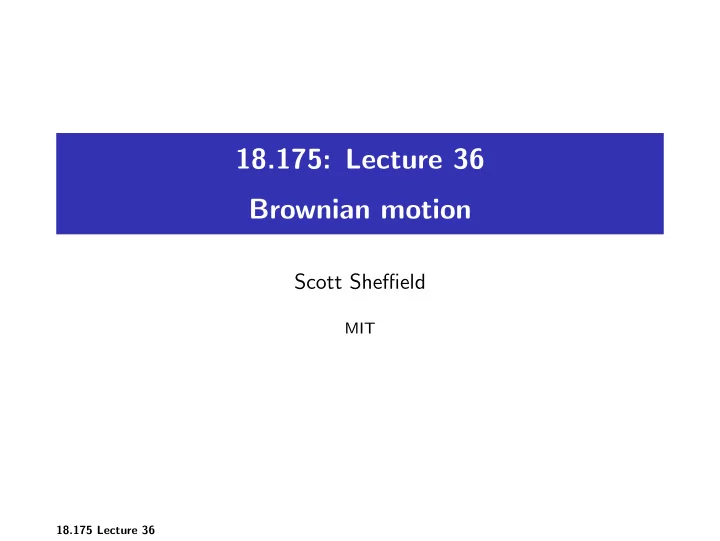

18.175: Lecture 36 Brownian motion Scott Sheffield MIT 18.175 Lecture 36
Outline Brownian motion properties and construction Markov property, Blumenthal’s 0-1 law 18.175 Lecture 36
Outline Brownian motion properties and construction Markov property, Blumenthal’s 0-1 law 18.175 Lecture 36
Basic properties � Brownian motion is real-valued process B t , t ≥ 0. � Independent increments: If t 0 < t 1 < t 2 . . . then B ( t 0 ) , B ( t 1 − t 0 ) , B ( t 2 − t 1 ) , . . . are independent. � Gaussian increments: If s , t ≥ 0 then B ( s + t ) − B ( s ) is normal with variance t . � Continuity: With probability one, t → B t is continuous. � Hmm... does this mean we need to use a σ -algebra in which the event “ B t is continuous” is a measurable? � Suppose Ω is set of all functions of t , and we use smallest σ -field that makes each B t a measurable random variable... does that fail? 18.175 Lecture 36
Basic properties Translation invariance: is B t 0 + t − B t 0 a Brownian motion? � � Brownian scaling: fix c , then B ct agrees in law with c 1 / 2 B t . � � Another characterization: B is jointly Gaussian, EB s = 0, � � EB s B t = s ∧ t , and t → B t a.s. continuous. 18.175 Lecture 36
Defining Brownian motion Can define joint law of B t values for any finite collection of � � values. Can observe consistency and extend to countable set by � � Kolmogorov. This gives us measure in σ -field F 0 generated by cylinder sets. But not enough to get a.s. continuity. � � Can define Brownian motion jointly on diadic rationals pretty � � easily. And claim that this a.s. extends to continuous path in unique way. Check out Kolmogorov continuity theorem. � � Can prove H¨ older continuity using similar estimates (see � � problem set). Can extend to higher dimensions: make each coordinate � � independent Brownian motion. 18.175 Lecture 36
Outline Brownian motion properties and construction Markov property, Blumenthal’s 0-1 law 18.175 Lecture 36
Outline Brownian motion properties and construction Markov property, Blumenthal’s 0-1 law 18.175 Lecture 36
More σ -algebra thoughts Write F o = σ ( B r : r ≤ s ). � � s Write F = ∩ t > s F o + � � s t + + Note right continuity: ∩ t > s F t = F s . � � + F allows an “infinitesimal peek at future” � � s 18.175 Lecture 36
Markov property If s ≥ 0 and Y is bounded and C -measurable, then for all � � x ∈ R d , we have E x ( Y ◦ θ s |F + ) = E B s Y , s where the RHS is function φ ( x ) = E x Y evaluated at x = B s . 18.175 Lecture 36
Blumenthal’s 0-1 law If A ∈ F + , then P ( A ) ∈ { 0 , 1 } (if P is probability law for � � 0 Brownian motion started at fixed value x at time 0). There’s nothing you can learn from infinitesimal neighborhood � � of future. 18.175 Lecture 36
MIT OpenCourseWare http://ocw.mit.edu 18.175 Theory of Probability Spring 2014 For information about citing these materials or our Terms of Use, visit: http://ocw.mit.edu/terms.
Recommend
More recommend